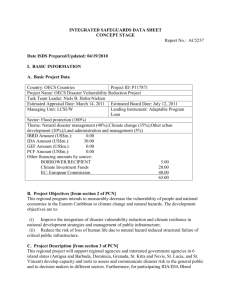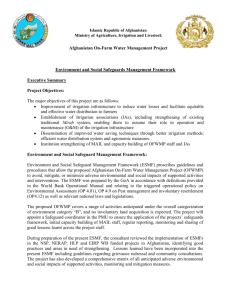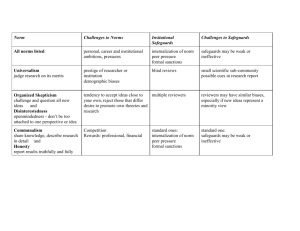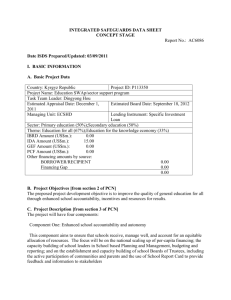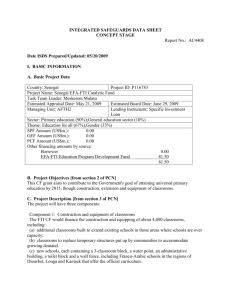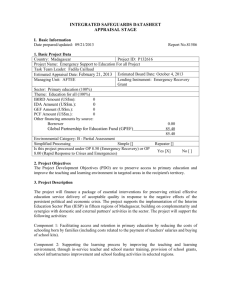Integrated Safeguards Data Sheet
advertisement
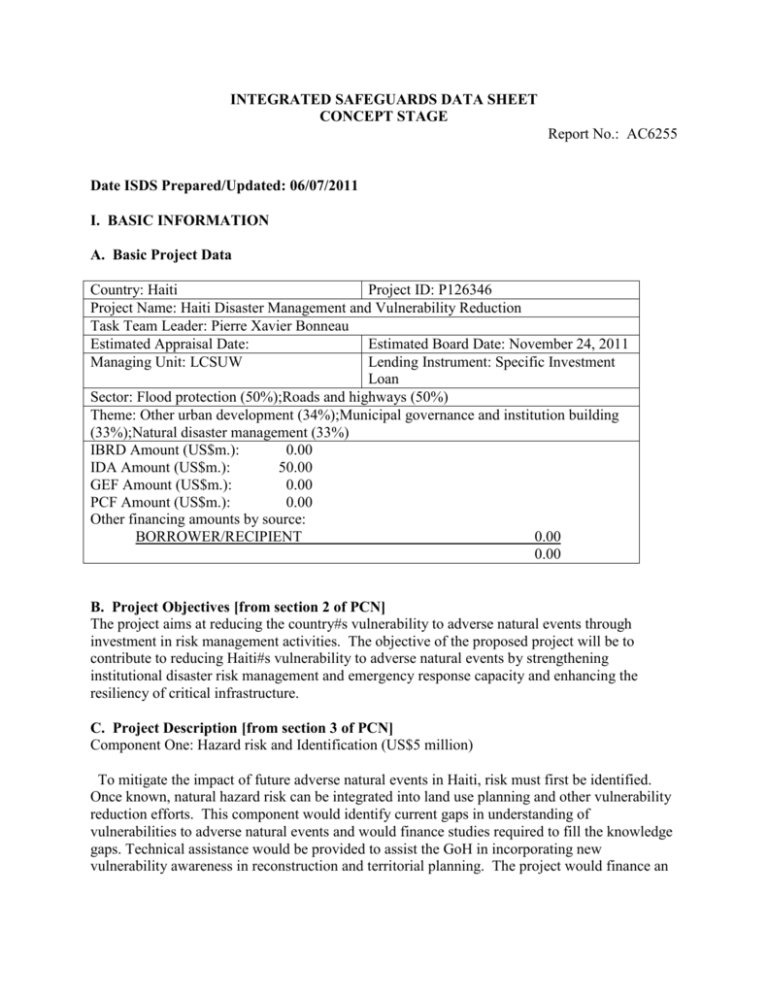
INTEGRATED SAFEGUARDS DATA SHEET CONCEPT STAGE Report No.: AC6255 Date ISDS Prepared/Updated: 06/07/2011 I. BASIC INFORMATION A. Basic Project Data Country: Haiti Project ID: P126346 Project Name: Haiti Disaster Management and Vulnerability Reduction Task Team Leader: Pierre Xavier Bonneau Estimated Appraisal Date: Estimated Board Date: November 24, 2011 Managing Unit: LCSUW Lending Instrument: Specific Investment Loan Sector: Flood protection (50%);Roads and highways (50%) Theme: Other urban development (34%);Municipal governance and institution building (33%);Natural disaster management (33%) IBRD Amount (US$m.): 0.00 IDA Amount (US$m.): 50.00 GEF Amount (US$m.): 0.00 PCF Amount (US$m.): 0.00 Other financing amounts by source: BORROWER/RECIPIENT 0.00 0.00 B. Project Objectives [from section 2 of PCN] The project aims at reducing the country#s vulnerability to adverse natural events through investment in risk management activities. The objective of the proposed project will be to contribute to reducing Haiti#s vulnerability to adverse natural events by strengthening institutional disaster risk management and emergency response capacity and enhancing the resiliency of critical infrastructure. C. Project Description [from section 3 of PCN] Component One: Hazard risk and Identification (US$5 million) To mitigate the impact of future adverse natural events in Haiti, risk must first be identified. Once known, natural hazard risk can be integrated into land use planning and other vulnerability reduction efforts. This component would identify current gaps in understanding of vulnerabilities to adverse natural events and would finance studies required to fill the knowledge gaps. Technical assistance would be provided to assist the GoH in incorporating new vulnerability awareness in reconstruction and territorial planning. The project would finance an information needs assessment, hazard risk and vulnerability analysis, and the provision of technical assistance to maximize the impact of new vulnerability understanding. Component Two: Building capacity of the National Disaster Risk Management System and mitigating disaster vulnerability (US$10 million) The National Disaster Risk Management System (SNGRD) has achieved important results in the areas of disaster preparedness and response. However, the system is relatively young and requires additional support to consolidate the gains achieved in the last five years. This component will seek to improve the capacity of the SNGRD to prepare for, and respond to, adverse natural events and mitigate the impact of such events through physical investments. The component will finance the provision of training, provision of technical advisory services, acquisition of goods, and the implementation of community level disaster mitigation works. Activities under this component would be divided into two categories # emergency preparedness and response, and disaster mitigation, and would include the following: Preparedness and Response: Through the provision of technical assistance and training for key SNGRD participants, operational emergency policies and procedures would be reinforced at the national level. At the municipal level the network of Civil Protection Committees would be expanded from 73 to over 100. In addition, the nationwide Early Warning System would be enhanced through training and the provision of equipment in order to strengthen the chain of command between various levels of government. Disaster Mitigation: In consultation with mayor#s offices, the community level Civil Protection Committees would benefit from training and technical assistance to more effectively conduct community level disaster vulnerability assessments. Based on local vulnerability assessments, physical mitigation measures will be designed and implemented. Possible types of investments include river training, slope stabilization and the retrofitting of critical infrastructure such as small bridges and culverts. Component Three: Rehabilitation of vulnerable and damaged transportation network infrastructure ($30 million) Damage from the earthquake continues to limit the efficiency of the transportation network, particularly the secondary road system outside of Port-au-Prince. The project will strengthen the institutional capacity of the SEPRRN (MTPTC Directorate for Road Maintenance), MTPTC preparation and crisis emergency response unit, Departmental Directorates of Public Works and the FER (Road Maintenance Fund) to prepare and supervise mitigation works or repairs to critical infrastructures, and to prepare and operate in an emergency response environment to restore access to isolated areas. The project would also finance the rehabilitation and reconstruction of damaged and vulnerable transport infrastructure, including: repairs of damaged critical points of infrastructures damaged by adverse natural events; consolidating existing infrastructure or critical points in order to improve resiliency, and completion new of works to support an all-weather transportation network. The institutional capacity to continue reducing vulnerabilities will also be strengthened. Component Four # Emergency Response Contingent Reserve (US$2 million) Following an adverse natural event, and subject to the GoH#s declaration of a national emergency in accordance with national law, this component would allow the GoH to request the World Bank to re-categorize financing and/or add contingent financing to cover early recovery and rehabilitation costs. Additional funds could also be made available through this window or funds could be re-allocated to this window from other components. Disbursements are expected to be made against a positive list of critical imports or the procurement of goods, works, and consultant services required to support the needs of the GoH. Component Five - Project Management and Implementation Support (US$3 million) Activities under this component would relate to the institutional support and capacity development for project management and implementation. Support will be provided to the two implementing agencies of the project, including the UCE-MTPTC and the UCP-MICT. Activities financed under this component would include training, staffing and project development activities associated with project execution. D. Project location (if known) The project would be implemented on the national level, benefitting all ten departments. The majority of physical works, which will be identified during project implementation, will take place in areas outside of Port-au-Prince. E. Borrower’s Institutional Capacity for Safeguard Policies [from PCN] Despite the emergency situation, environmental and social safeguards measures have been applied in various CDD and transport sector rehabilitation projects. Experiences and instruments developed for the HIIERP, PRODEP and PRODEPUR projects will serve as a foundation for the proposed project#s safeguard policies and procedures. The project will be implemented by two agencies. Components 1, 2, 4 and 5 will be the responsibility of the Project Implementation Unit of the Ministry of Interior and Collective Territories (Unité de Coordination de Projet du Ministère de l#Intérieur et des Collectivités Territoriales: UCP # MICT). They would also be responsible for overall project reporting responsibilities. The UCP has experience with Bank safeguards policies. The majority of the physical investments will take place under Component 3 of the proposed Project. Similar to other World Bank financed operations, the Project Implementation Unit of the Ministry of Public Works, Transportation and Communications (Unité Centrale d#Exécution du Ministère des Travaux Publics, Transports et Communications: UCE - MTPTC) will be charged with implementation of physical investments. The UCE has a history of implementing Bank financed projects and supervising implementation partners in the application of social and environmental safeguards. A social specialist is in place at the UCE to cover safeguards aspects of Bank projects and they are in the process of including an environmental specialist to provide further assistance with the application of the Bank#s environmental safeguard policies. Physical works will be completed by implementing partners and supervised by the UCE. Many large implementing partners are experienced in Bank safeguard policies; however, additional training will be provided to ensure that the implementing partners comply with safeguards policies. If necessary, the UCE will also benefit from training and capacity building in the supervision of Bank safeguards. The Bank has been collaborating closely with other donors, including the IDB on consistent application and enforcement of safeguards. For example, a joint Bank/IDB social and environmental safeguards workshop was organized in September 2010 to raise the importance of these issues with the GoH and discuss their integration in all projects. The proposed Project will benefit from this partnership and will aim to strengthen coordination. F. Environmental and Social Safeguards Specialists Ms Nyaneba E. Nkrumah (LCSEN) Mr Fabio Pittaluga (LCSSO) II. SAFEGUARD POLICIES THAT MIGHT APPLY Safeguard Policies Triggered Yes No TBD Environmental Assessment (OP/BP 4.01) X OP/BP 4.01 is triggered due to: i) the construction of emergency operation centers under Component 2; ii) rehabilitation of damaged assets under Component 3; and, iii) community level investments under Component 2, which may include river training, slope stabilization and critical infrastructure construction retrofitting (e.g., small bridges, culverts, etc). For each of these activities, every effort will be made to minimize their environmental impact. For example, large scale river diversions will not be funded and every effort will be made to ensure that the scale of river training is small with no impact on aquatic and terrestrial habitats. An ESMF will be prepared to assess these impacts and, where required, an Environmental Management Plan (EMP) will be prepared. The project is being processed under emergency guidelines (OP/BP 8.00). Under these guidelines, the preparation of impact assessments and safeguards instruments, along with disclosure of documents, will be finalized following Board approval. However, a draft Environmental and Social Management Framework (ESMF) will be prepared prior to the Decision Meeting. The ESMF will indicate the processes and procedures for all actors to ensure compliance with all applicable Bank policies both in environment and social matters. In so far as needed, if specific plans are required by individual infrastructure investments, these will be developed. Scope and Scale of Impacts: Physical activities considered under this project relate to the rehabilitation and strengthening of existing infrastructure and are not expected to produce any large-scale, significant and/or irreversible impacts. As a result, we recommend that the Project be given an environmental category of B. Safeguard Policies Triggered Yes No TBD Works to be financed by the project will be identified during project implementation. The majority of investments will be the rehabilitation of existing transportation network infrastructure based on the principle of greatest loss avoidance and would generally focus on rehabilitating damaged assets before they fall to a level beyond repair. Community level works would be identified through a consultative process among the community affected and investments envisioned include river training, slope stabilization, and critical infrastructure construction retrofitting (small bridges, culverts, etc). Recent Experience: In the post-earthquake context in Haiti, where the social and environmental context has changed significantly, the Bank has financed the rehabilitation of roads and community level infrastructure. The proposed project will incorporate these experiences and lessons learned in the drafting of the ESMF. Training in the implementation of Bank safeguards will be provided to the UCE and implementing partners to ensure compliance. Completion and disclosure of key safeguards instruments are expected within the first six months after the project has been approved; however, the Project Operational manual, to be prepared for Grant effectiveness, will include the ESMF core principles. Natural Habitats (OP/BP 4.04) X The primary purpose of river training is flood control. This activity may have the potential to alter the river flow, gradient, temperature, etc, which, in turn, may particularly impact the habitat of aquatic species. At the concept stage, and without an assessment, it is not possible to determine whether natural habitats will be negatively impacted. This depends on the river course chosen to prevent flooding, the scale of the training and the extent to which the water course is altered. However, as per Bank safeguard policies, no conversion or alteration of critical habitat or fragile ecosystems will occur and large scale river diversions will not be financed. Minimal river training, if selected as an activity, will be technically assessed prior to implementation. An EMP will prepared if there is going to be a significant impact on the natural habitat. Forests (OP/BP 4.36) X Pest Management (OP 4.09) X Physical Cultural Resources (OP/BP 4.11) X Small rehabilitation works and new minor mitigation works may result in the chance find of culturally significant objects. A section governing chance finds will be addresses in all physical works contracts Indigenous Peoples (OP/BP 4.10) X Involuntary Resettlement (OP/BP 4.12) X Works financed under the project are envisioned to be focused on the repair of existing infrastructure. The likelihood of resettlement as a result of construction is expected to be very minimal; however, in some cases, this may be required on a limited basis. In the case that a small number of individuals and/or families need to be moved, abbreviated resettlement plans will be prepared prior to construction. The exact location of the specific activities to be financed will only be defined during project implementation. Thus a Resettlement Policy Framework (RPF) will be prepared and integrated into the Environmental and Social Management Framework for the project. The RPF/ESMF will illustrate the modalities by which compliance with OP 4.12 will be ensured, and Safeguard Policies Triggered Yes No TBD lay out a series of processes for the identification of resettlement impacts and the modalities by which these can be mitigated or avoided as needed. The resettlement framework will be based on that which was developed for the recent CDD projects, which has application for both rural and urban areas. The RPF/ESMF will illustrate a clear and simple procedure to be applied to each project that is easily understood by implementing partners. Recent Experience: The proposed Project will benefit from the lessons learned in the implementation of several post-earthquake rehabilitation projects. For example land tenure and property tenure in Haiti is especially unclear as a result of the earthquake; however, ongoing CDD projects are in the process of carrying out social assessment studies to develop better understand these challenges, including a study on gender issues to better understand how resettlement could affect women differentially than men. These studies are in the process of being conducted and will provide useful information on any resettlement for the project and if and when needed. In the case of resettlements, the proposed Project would provide additional training and capacity building to the UCE and the implementing partners and the Bank will ensure that the UCE receives necessary inputs throughout the process. Conflict Resolution mechanisms: During the preparation and implementation phases, community members may have various disputes, complaints and/or grievances on a variety of issues including inclusion in the community-based mapping lists, entitlement to assistance, or on the manner in which the assistance is provided. It is important, therefore, to have widely disseminated, easily accessible, and well functioning conflict resolution mechanisms in place prior to the beginning of any works under the housing component that clearly distinguish between different types of problems: (a) disputes / disagreements on fact (e.g., property boundaries), (b) grievances from parties who do not like the outcome of the project activities, and (c) complaints about the project processes themselves. The Conflict Resolution Mechanisms should build on existing community-based practices and processes. The newly recruited social specialist in the UCP will oversee all project grievance mechanisms. Representatives of the Mayor#s office, other NGOs involved in the reconstruction effort, and international stakeholders experienced in facilitating transparent processes, are some of the possible candidates for participation in the conflict resolution mechanism. Safety of Dams (OP/BP 4.37) X Projects on International Waterways (OP/BP 7.50) X Projects in Disputed Areas (OP/BP 7.60) X Environmental Category: B - Partial Assessment III. SAFEGUARD PREPARATION PLAN A. Target date for the Quality Enhancement Review (QER), at which time the PAD-stage ISDS would be prepared: N/A B. For projects that will not require a QER, the target date for preparing the PAD-stage ISDS: 07/13/2011 C. Time frame for launching and completing the safeguard-related studies that may be needed. The specific studies and their timing1 should be specified in the PAD-stage ISDS. The project is processed under OP 8.00 as an emergency operation, which allows for the preparation of impact assessments and safeguards instruments, along with disclosure of documents, to be completed following Board approval. However, the team will develop a draft Environmental and Social Management Framework (ESMF) prior to the Decision Meeting. This ESMF will be based on recent Frameworks developed in Haiti in the post-earthquake environment. Completion and disclosure of the ESMF is expected to be finalized within the first six months after the project has been made effective. IV. APPROVALS Signed and submitted by: Task Team Leader: Approved by: Regional Safeguards Coordinator: Comments: Sector Manager: Comments: 1 Mr Pierre Xavier Bonneau 06/06/2011 Mr Glenn S. Morgan 06/06/2011 Ms Sylvie Debomy 06/06/2011 Reminder: The Bank's Disclosure Policy requires that safeguard-related documents be disclosed before appraisal (i) at the InfoShop and (ii) in-country, at publicly accessible locations and in a form and language that are accessible to potentially affected persons.

